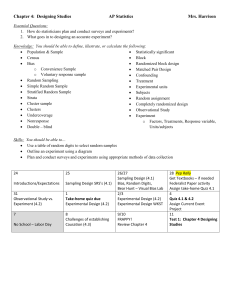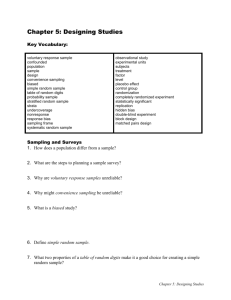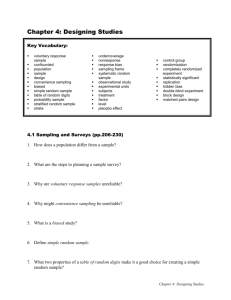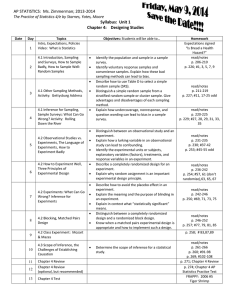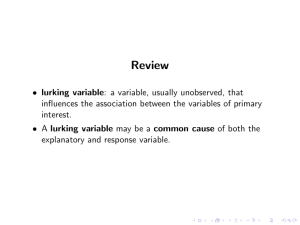Chapter 4: Designing Studies Key Vocabulary:
advertisement
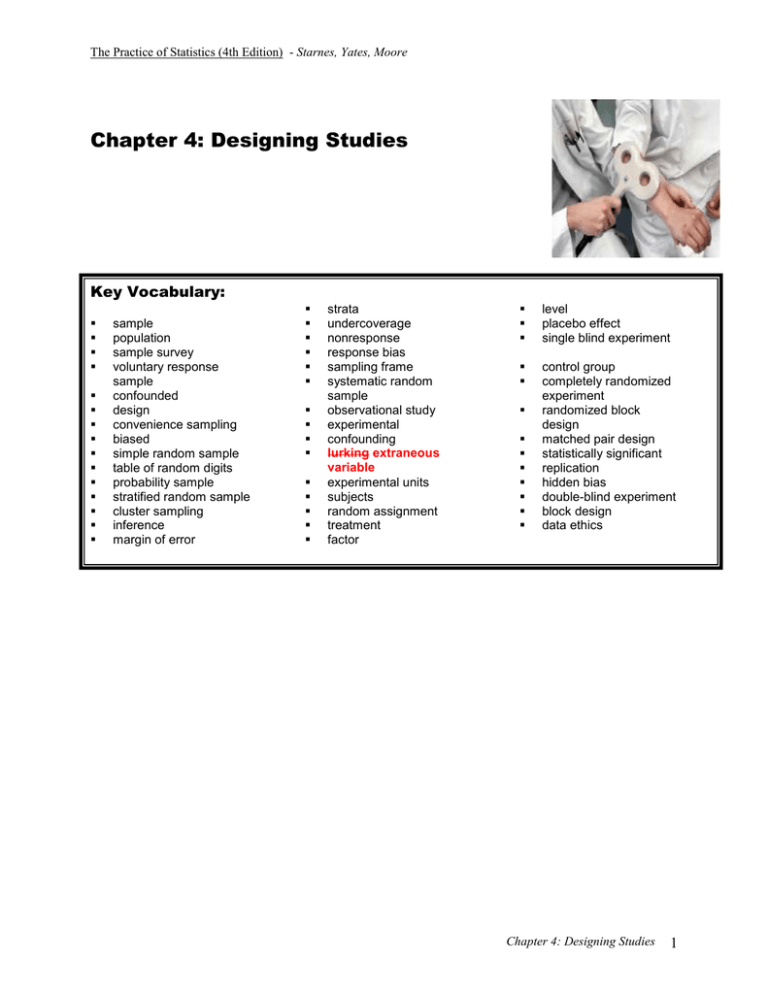
The Practice of Statistics (4th Edition) - Starnes, Yates, Moore Chapter 4: Designing Studies Key Vocabulary: sample population sample survey voluntary response sample confounded design convenience sampling biased simple random sample table of random digits probability sample stratified random sample cluster sampling inference margin of error strata undercoverage nonresponse response bias sampling frame systematic random sample observational study experimental confounding lurking extraneous variable experimental units subjects random assignment treatment factor level placebo effect single blind experiment control group completely randomized experiment randomized block design matched pair design statistically significant replication hidden bias double-blind experiment block design data ethics Chapter 4: Designing Studies 1 The Practice of Statistics (4th Edition) - Starnes, Yates, Moore 4.1 Sampling and Surveys (pp.206-224) 1. Explain the difference between a population and a sample. 2. What is involved in planning a sample survey? 3. Why might convenience sampling be unreliable? 4. What is a biased study? 5. Why are voluntary response samples unreliable? 6. Define simple random sample (SRS). 7. What two properties of a table of random digits make it a good choice for creating a simple random sample? 8. State the two steps in choosing an SRS: 9. What is the difference between sampling with replacement and sampling without replacement? 10. How can you account for this difference with and without replacement when using a table of random digits or other random number generator? 11. How do you select a stratified random sample? 2 The Practice of Statistics (4th Edition) - Starnes, Yates, Moore 12. What is cluster sampling? 13. What is inference? 14. What is a margin of error? 15. What is the benefit of a larger sample size? 16. A sampling frame is… 17. Give an example of undercoverage in a sample. 18. Give an example of nonresponse bias in a sample. 19. Give an example of response bias in a sample. 20. How can the wording of questions cause bias in a sample? 21. Answer the two questions for the Check Your Understanding on page 224. 3 The Practice of Statistics (4th Edition) - Starnes, Yates, Moore 4.2 Experiments (pp.231-251) 1. Explain the differences between observational study and experiment. 2. A lurking variable is… 3. What problems can lurking variables cause? 4. Confounding occurs when… 5. Answer the four questions for the Check Your Understanding on page 233. 6. Explain the difference between experimental units and subjects. 7. Define treatment. 8. By studying the TV Advertising example on page 235, identify the factors and levels in the experiment. 9. Explain why the example, Which Works Better: Online or In-Class SAT Preparation, is a bad experiment. 10. What is random assignment? 11. What is a comparative experimental design? 12. In a completely randomized design… 4 The Practice of Statistics (4th Edition) - Starnes, Yates, Moore 13. Does using chance to assign treatments in an experiment guarantee a completely randomized design? Explain. 14. What is the significance of using a control group? 15. The basic principles of statistical design experiments are: 16. Define control, random assignment and replication in experimental design. 17. Describe the placebo effect. 18. What are the differences between a double-blind and single-blind experiement? 19. Define statistically significant. 20. What is a block? 21. What is a randomized block design? 22. When does randomization take place in a block design, and how does this differ to a completely randomized design? 23. What is the goal of a matched pairs design? 24. When is it beneficial to use a blocked/paired design? How should we choose which variables to block for? 5 The Practice of Statistics (4th Edition) - Starnes, Yates, Moore 4.3 Using Studies Wisely (pp.261-267) 1. Name the two types of inferences that can be identified based on the design of a study. 2. Name the challenges of establishing causation. 3. What are the four criteria for establishing causation when we can’t do an experiment? 4. Briefly describe the basics of data ethics. 6

